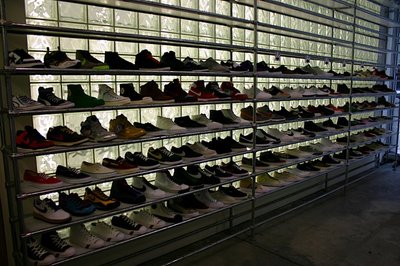Saving Soles
Comments (11)
They call themselves sneakerheads.
They collect sneakers for obsessive reasons that extend well beyond simply having the proper footwear for everyday living. These sneakers are not just shoes. These sneakers are individual expression in the form of a sole, laces and a tongue, sprinkled with a touch of personal flavor.Each personal assemblage of sneakers is unique.
Around Los Angeles, these laced-up shrines contribute to an ever-growing sneaker culture. Sneakerheads amass all kinds of shoes: Air Max Nikes, Dunks, Jordans, Stabs, Blazers and Forces in an effort to expand their compilation of treasures and outdo their fellow die-hard sneaker fans. An inventory of 30 pairs might get you in the sneakerhead door, but it's going to take over 200 to get you into the VIP section.
Forget loafers, stilettos or pumps; we're talking strictly sneakers here. If you're old school, you might have countless pairs of Nike Air Force Ones - the crème de la crème of Nike Footwear. Created in 1982, the shoe was the first to use Nike's signature Nike Air Technology. Twenty-six years later, its design has remained unchanged. While the classic version comes in a clean white-on-white color, there are thousands of different color combinations, enough to keep everybody satisfied. Know the right people and you can take the white-on-white originals and have them painted or customized any way your sneaker heart desires.

Sneaker collecting has its origins in 1970s' New York, where kids immersed in the city's hip-hop culture would purchase the latest Converse brand sneakers before other brands entered the market.
"In the 1970s, colorful sneakers made by Adidas, Puma and Nike began to eclipse traditional Converses on the basketball courts and sidewalks, and a fetish was born," said New Yorker magazine in an editorial review of the book "Where'd You Get Those? New York City's Sneaker Culture: 1960-1987."
"New York City is a fanatical coalition of basketball players, graffiti writers, break dancers and rappers devoted to the stylistic possibilities of these shoes, making cults of certain models, coloring and customizing them and devising elaborate lacing patterns," the article says.
The culture's ties to the hip-hop community helped spread its popularity nationwide. When Nike invented the "Air Jordan" shoe in 1985, it was one of the first to use style and design--elements that fuel hip-hop--on the basketball court. Before Michael Jordan's first signature shoe, most basketball shoes were white. The Air Jordan I debuted in a black and red color, and Air Jordans have been a staple among sneakerheads ever since.
Helen Sugano, 22, became interested in sneaker collecting while working at Champs Sports, a popular footwear chain, in 2006. A hip-hop fan, Sugano began to see sneakers as another way of expressing hip-hop culture. At Champs, an employee discount and early access to the latest shoes that other sneakerheads waited in line overnight for led Sugano to start buying Air Jordans whenever she could. "Then it turned into a lot more than that," she said, lifting her gaze from the ground with a smile.
Once Sugano began to learn about the most sought-after sneakers, she began to meet other people that shared her interest. After that, Sugano admitted she was addicted to sneakers.
"Then it turned into a, 'Well you think your shoes are fresh? Mine are better,' type of game," she said. "And I became obsessed."
Sugano talks about sneakers in a vernacular peculiar to sneaker culture. Shoes purchased without any intention of lacing them up to flaunt on the town are called "deadstock." The various colors released for the same type of shoe are the different "colorways." (While the original Air Jordans came in black and red, alternative colorways soon emerged, like blue and black, white and red etc...) The terms are interwoven into Sugano's sentences like crisp white laces in a new pair of Air Forces.
Her story is a common one in the world of sneaker culture. Collections start out small. Sneakerheads typically begin to purchase a few pairs that they like. Once they have a nice, steady base established, the number of soles grows like a child accumulating baseball cards. Sure, everybody has a pair of Air Jordan IIIs--a standard pair costs about $90--but only the elite are going to be able to get their hands on a pair of limited edition Fukiyama Air Force Ones. They're prepared to pay over $1,000 for any exclusive pair of Forces, and that pricing is conservative.
Many sneakerheads follow the code of deadstock, leaving the shoes tucked away in a closet that resembles back room inventory. If they are worn, the utmost care must be taken to make sure that they maintain their "freshness." Proper cleaning technique with specific shoe cleaner solution, using "decreasers" inside the shoe to avoid wrinkles in the front of the shoe, and even planning out the night's activities all go into consideration.
"I wear mine only because if I'm going to spend over $150 on a pair of shoes, I'm gonna rock them," Sugano said. "But I only wear them in situations where I know they're not going to get ruined, wet, or have drinks spilled on them."
Other sneakerheads buy two pairs of each sneaker--one to wear out and the other to preserve in the original box.
Sugano said she owns about 40 pairs of sneakers, all Nikes but six or seven different kinds. Her favorite? "Zebra horsehair Blazers," she gushes.
A swirling design of real, coarse black and off-white horse hair that resembles well, a zebra, with laces encircles the high-top Nikes and the brand's signature swoosh in white. Sugano bought hers at the retail price of $140, but the resell value would be sufficient for her to make a substantial profit. Needless to say, these shoes are not for resale.
Sugano's biggest challenge is finding the upper-echelon shoes in her size. A men's size six, Sugano quips that all of the most limited colorways are made for guys, and her size isn't exactly the most prevalent on the shelves. Still, she says collecting these exclusive sneakers beats typically "girly" footwear.
"I know other girls who have a lot of shoes but they're usually heels and girl shoes, or stuff like Vans and Chucks that are cheap and easy to get," Sugano said.
"Or they just have whack sneakers and think they're cool," she joked.
Sugano takes pride in her collection, but grudgingly acknowledges that other guys she knows have collections of more than 300 pairs. "Their apartments look like stock rooms," she says.
"Compared to all the dudes I know [who] collect, what I have is peanuts."
Regardless, she's part of sneaker culture for the camaraderie and the chase for that next pair of exclusive Nike Dunks.
"It's like a treasure hunt. I'm just lucky to have a few connections here and there."



